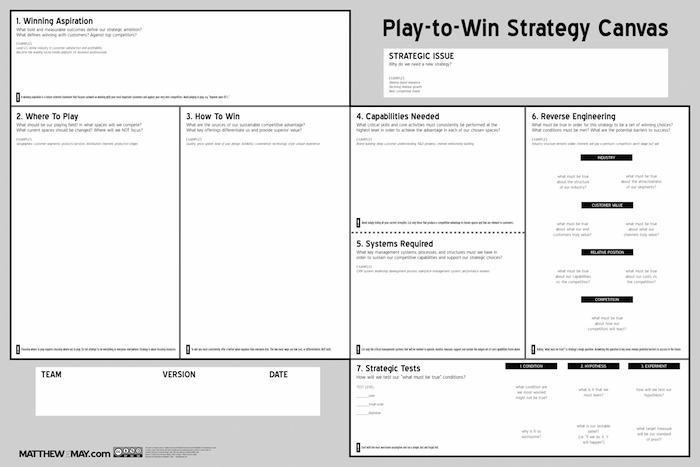Introducing the Play-to-Win Strategy Canvas 2.0

I started developing a visual tool for team facilitation of strategy development over two years ago, after I learned the Playing to Win framework from Roger Martin. I’ve always liked using good old paper and Post-Its, ever since I learned what was affectionately referred to as “the big paper process†when I was working with Toyota many years ago.
After dozens of iterations I’ve finally settled on a format that people find simple, fun, and effective. And for a limited time, I’m going to make it available free under a Creative Commons License, which essentially means you can use and tweak it providing you include attribution, and don’t try to monetize it in any way.
Here’s what it looks like. It captures the entire strategy formulation process, including the identification of the key strategic issue, reverse engineering, and initial test design, as detailed in Roger Martin and A.G. Lafley’s book, Playing to Win. (Disclosure: Roger Martin has seen the various iterations and advised me on changes.)

The previous version was not standalone. This one is. It is designed to be at once a visual tool, a creative device, a standard operating procedure, and an artifact of a team’s strategic thinking. There are guiding questions as well as tips to keep in mind for each key stage of strategy development.
The process for using it is straightforward: print the canvas, grab some Post-It notes (large and small, various colors), a sharpie, and start working. I will be providing a facilitation guide in the future. For now, know that the only rule is “don’t write on the canvas!†The exception being your/your team’s name. Everything else is meant to be movable and flexible, thus iterative and loopy.
My own personal strategy formulation process goes something like this:
- Map the current strategy using yellow Post-It notes, boxes 1 through 5. If you’re using the wall size, use 3×3. For the A3 size, use 1.5 x 2.
- Identify the key issue with the current strategy, write it on a Post-It and put it in its place.
- Draft a new strategy. Use different colored Post-Its if you wish to use a single canvas. Otherwise, use a separate canvas for the new strategy.
- Think through what must be true for your strategy to be valid (box 6). Identify your most worrisome assumption.
- Craft a “lean†experiment focused on your most worrisome what-must-be-true.
I’ve produced the canvas in two sizes: a wall size poster (54 x 36 inches), and a placemat A3 size (11 x 17 inches). I’m contemplating an iPad app for it.
To download the wall poster, click HERE.
To download the A3 placemat, click HERE.
The Play-to-Win framework is one of the simplest but most powerful frameworks I’ve run across, and I use it both mentally and physically for all significant choicemaking. It’s made me a far more, er, choiceful individual.
I even used the A3 to map out the strategy for my latest book, Winning the Brain Game: Fixing the Seven Fatal Flaws of Thinking,which is available now.
Wait! Before you go…
Choose how you want the latest innovation content delivered to you:
- Daily — RSS Feed — Email — Twitter — Facebook — Linkedin Today
- Weekly — Email Newsletter — Free Magazine — Linkedin Group
 Matthew E. May is the author, most recently, of Winning the Brain Game: Fixing the 7 Fatal Flaws of Thinking.
Matthew E. May is the author, most recently, of Winning the Brain Game: Fixing the 7 Fatal Flaws of Thinking.
NEVER MISS ANOTHER NEWSLETTER!
LATEST BLOGS
Three things young people should know about apprenticeships
Photo by Mars on Unsplash Times are changing for young people after they leave school. Once, no one went to…
Read MoreThree top tips for young adults working from home
Photo by Mateus Campos Felipe on Unsplash In the past couple of years, working from home has become the new…
Read More


